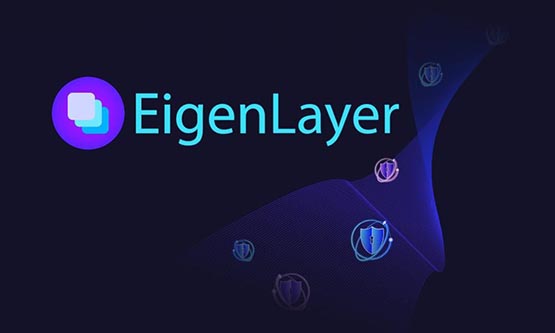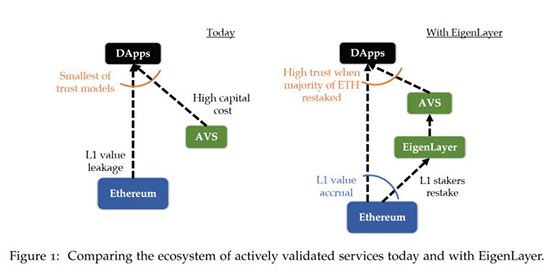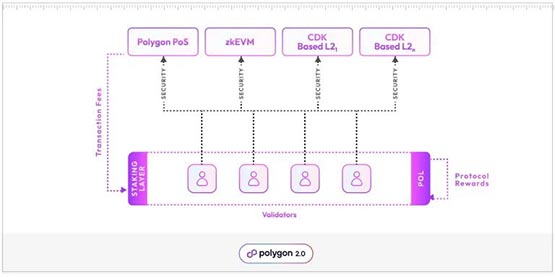
The restaking protocol (Restaking) is not only featured in the Eigenlayer and Ethereum ecosystems. Crypto researcher Ignas pointed out that rapidly developing restaking protocols have also appeared in ecosystems such as Polygon, Solana, and Cosmos. Pledge project.
The concept of re-pledge was proposed by the EigenLayer protocol, which allows users to pledge ETH or stETH to support their nodes to protect the security of the external network. Combining insecure decentralized networks with the security of Ethereum through economically incentivized staking.

EigenLayer seamlessly delivers the security of Ethereum to decentralized infrastructure
There are many examples of decentralized networks that require security from the outside, Examples include projects like Celestia and ChainLink. By combining themselves with the security of Ethereum, they can reduce the difficulty of cold starts with the help of EigenLayer. In addition, there are many sidechain projects that also provide a data availability layer, further enhancing the security of the network. The emergence of these projects means that future decentralized networks no longer need to build security from scratch, but can instead rely on these existing solutions.
In fact, the concept of re-pledge is not original to EigenLayer. Many ecosystems have already had similar projects.
Other ecosystems are also exploring this concept, including future updates of Polygon, Cosmos’ multi-chain ecosystem, Solana’s Picasso project, and Near’s Octopus Network.
The Polygon2.0 plan includes providing services for users to pledge new tokens POL to obtain mainnet rewards (POL additional issuance). POL token holders can also stake tokens to support various nodes and run external decentralized networks, forming a multi-chain ecosystem based on the security of the Polygon mainnet.

Polygon2.0 pledge to protect multi-network ecology
In addition to supporting the security of external blockchains, Polygon2.0 is expected to also support aggregation networks , DAO and various other facilities that require security support.
The Cosmos ecosystem originally allows users to stake ATOM tokens to protect networks in other ecosystems. Ignas noted that Neutron is the first network to accept staking of this ATOM for security.
The Picasso project in the Cosmos ecosystem brings the concept of re-pledge to the Solana network. Users can pledge SOL, mSOL, jitoSOL and other LP tokens to support Solana cross-chain IBC verifiers are expected to be able to extend security to other networks or facilities in the future.
Octopus Network, which supports application chains in the Near ecosystem, has long been a pioneer in the re-staking track. Both users and project teams can pledge NEAR tokens to ensure security. Sexually extended to the application chain on Octopus Network.
Currently the first supported external network on Octopus Network is Ottochain, and more decentralized networks will be supported in the future.
In fact, the concept of re-staking is the same as that of early application chains. However, due to the nature of the pledged assets, you may be able to enjoy multiple benefits. For example, you can get multiple benefits by pledging stETH at the same time. Ethereum consensus rewards and token rewards for potential re-staking projects. So the concept is actually similar, but it's just repackaged by the market.
The concept of re-pledge is not new, but EigenLayer has indeed carried it forward, and combined with the explosive growth in the field of liquid pledged derivatives (LSD) such as Lido in recent years, once again promoted the rationality of the re-pledge narrative.
It can be seen that the currency circle is indeed driven by narrative, which often dazzles the participants. It may not be very healthy from an innovation perspective, but it is undeniable that from a market perspective, the industry has indeed received more attention and development as a result.
As a participant, if you can think from a higher level perspective, you can more clearly identify the real innovation points, and more accurately distinguish the rationality of market ups and downs, which will help you make more accurate judgments. .
The above is the detailed content of Review of other staking protocols (Restaking) except EigenLayer. For more information, please follow other related articles on the PHP Chinese website!




